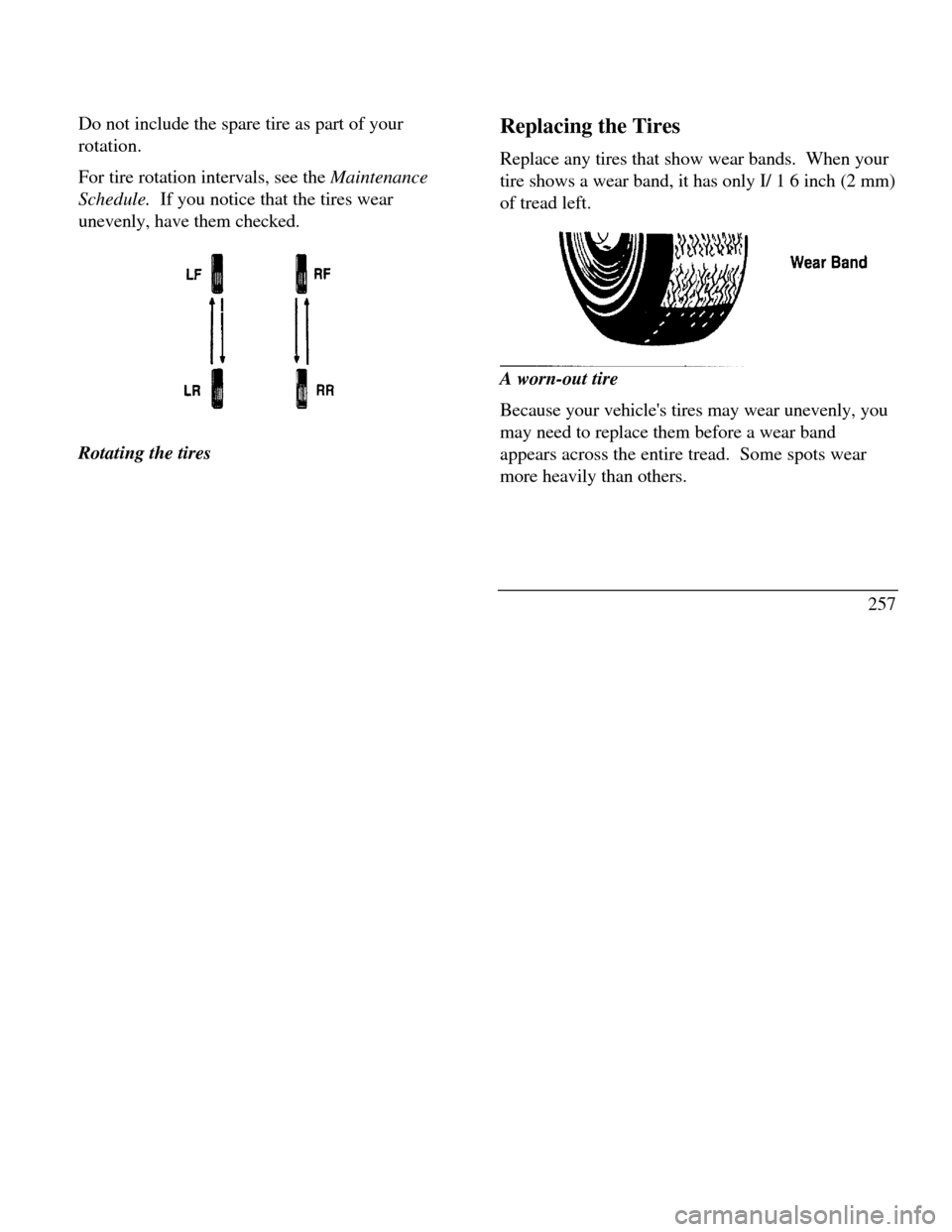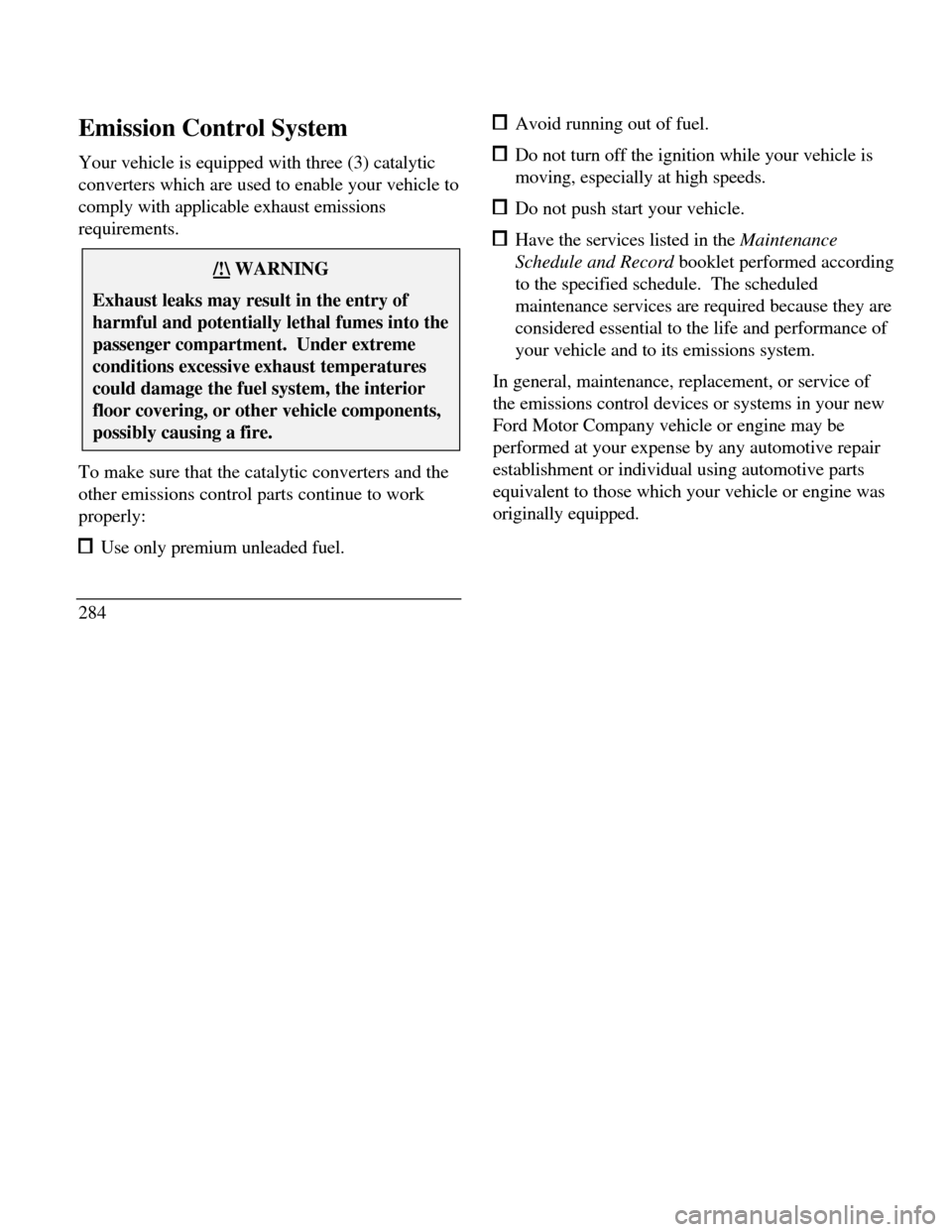1996 LINCOLN CONTINENTAL maintenance
[x] Cancel search: maintenancePage 255 of 320

The low-maintenance battery has removable vent
caps for checking the electrolyte level and adding
water. The electrolyte level should be checked at
least every 24 months or 24,000 miles (40,000 km)
in temperatures up to 90'F (32'C) and more often in
temperatures above 90'F (32'C). Keep the
electrolyte level in each cell up to the level
indicator. Do not overfill.
If the level gets low, refill the battery with distilled
water. If necessary, you can add tap water to the
battery, provided the water is not hard or does not
have a high mineral or alkali content. If the battery
needs water quite often, have the charging system
checked for a possible malfunction.
Help Us Protect Our Environment
Ford Motor Company strongly recommends that
used lead-acid batteries be returned to an authorized
recycling facility for disposal.Battery recycling symbol
Because your vehicle's engine is electronically
controlled by a computer, some control conditions
are maintained by power from the battery. If you
ever disconnect the battery or install a new battery,
you must allow the computer to "relearn" its idle
conditions before your vehicle will drive properly.
To let the engine do this, put the gearshift in P
(Park), turn off all the accessories, and start the
vehicle. Let the engine idle for at least one minute.
(Engine must be warm in order to "learn.") Also,
allow approximately 10 miles (16 km) of stop and go
traffic for your vehicle's engine to completely
girelearn" its idle.
253
Page 259 of 320

Do not include the spare tire as part of your
rotation.
For tire rotation intervals, see the Maintenance
Schedule. If you notice that the tires wear
unevenly, have them checked.Rotating the tiresReplacing the Tires
Replace any tires that show wear bands. When your
tire shows a wear band, it has only I/ 1 6 inch (2 mm)
of tread left.A worn-out tire Wear Band
Because your vehicle's tires may wear unevenly, you
may need to replace them before a wear band
appears across the entire tread. Some spots wear
more heavily than others.
257
Page 263 of 320

See Securitires in the Features chapter for more
information.
Automatic Transaxle Fluid
Under normal circumstances, you do not need to
check the fluid level of the transaxle, since your
vehicle does not use up transaxle fluid. Refer to the
Maintenance Schedule and Record booklet for
replacement intervals. However, if the transaxle is
not working properly - for instance, the transaxle
may slip or shift slowly, or you may notice some
sign of fluid leakage - the fluid level should be
checked.
NOTE: If the vehicle has been operated for an
extended period at high speeds or in city traffic
during hot weather, or pulling a trailer, the vehicle
should be turned off for about 30 minutes to allow
the fluid to cool before checking.Checking the Automatic Transaxle Fluid
With the vehicle on a level surface and the brake fully
applied, start the engine and move the gear shift
selector through all of the gears allowing sufficient
time for each position to engage. Securely latch the
gear shift selector in the P (Park) position. Fully set
the parking brake and leave the engine running.
Wipe off the dipstick cap and pull the dipstick out.
Wipe the indicator end clean. Put the dipstick back
into the filler tube and make sure it is fully seated.
Pull the dipstick out and read the fluid level.
NOTE: Your vehicle should not be driven until
some fluid has been added if the fluid level is below
the bottom dimple on the dipstick and the outside
temperature is above 50°F (10°C). Add only enough
fluid to bring the level above the bottom hole.
261
Page 286 of 320

Emission Control System
Your vehicle is equipped with three (3) catalytic
converters which are used to enable your vehicle to
comply with applicable exhaust emissions
requirements./!\ WARNINGExhaust leaks may result in the entry ofharmful and potentially lethal fumes into thepassenger compartment. Under extremeconditions excessive exhaust temperaturescould damage the fuel system, the interiorfloor covering, or other vehicle components,possibly causing a fire.To make sure that the catalytic converters and the
other emissions control parts continue to work
properly: Use only premium unleaded fuel.
284 Avoid running out of fuel. Do not turn off the ignition while your vehicle is
moving, especially at high speeds. Do not push start your vehicle. Have the services listed in the Maintenance
Schedule and Record booklet performed according
to the specified schedule. The scheduled
maintenance services are required because they are
considered essential to the life and performance of
your vehicle and to its emissions system.
In general, maintenance, replacement, or service of
the emissions control devices or systems in your new
Ford Motor Company vehicle or engine may be
performed at your expense by any automotive repair
establishment or individual using automotive parts
equivalent to those which your vehicle or engine was
originally equipped.
Page 287 of 320

Ford strongly recommends the use of genuine Ford
replacement parts. If other than Ford or
Motorcraft parts or Ford authorized
remanufactured parts are used for maintenance
replacements or for the service of components
affecting emission control, such non-Ford parts
should be equivalent to genuine Ford Motor
Company parts in performance and durability. It is
the owner's responsibility to determine the
equivalency of such parts. Please consult your
warranty booklet for complete warranty
information./!\ WARNINGDo not park, idle, or drive your vehicle in drygrass or other dry ground cover. Theemission system heats up the enginecompartment and exhaust system, which canstart a fire.Watch for fluid leaks, strange odors, smoke, loss
of oil pressure, the charge warning light, the checkengine light, or the temperature warning light. These
sometimes indicate that the emission system is not
working properly.
Do not make any unauthorized changes to your
vehicle or engine. Changes that cause more unburned
fuel to reach the exhaust system can increase the
temperature of the engine or exhaust system.
By law, anyone who manufactures, repairs, services,
sells, leases, trades vehicles, or supervises a fleet of
vehicles is not permitted to intentionally remove an
emission control device or prevent it from working.
In some of the United States and in Canada, vehicle
owners may be liable if their emission control device
is removed or is prevented from working.
Do not drive your vehicle if it does not operate
properly. See your dealer if the engine runs on for
more than five seconds after you shut it off or if it
misfires, surges, stalls, or backfires.
285
Page 288 of 320

Information about your vehicle's emission control
system is on the Vehicle Emission Control
Information decal located on or near the engine.
This decal identifies engine displacement and gives
some tune-up specifications.
Readiness for Inspection/Maintenance
Testing
In some localities it may become a legal requirement
to pass an Inspection/Maintenance (I/M) test of the
On-Board Diagnostic (OBD) II system. If the
vehicle's powertrain system or its battery has just
been serviced, the OBD II system is reset to a not
ready for I/M testing condition. To prepare for I/M
testing, the law specifies a "need for additional
mixed city and highway driving to complete the
check" of the OBD II system. As soon as all of the
OBD II system checks are successfully completed,
the OBD II system is set to the ready condition. The
amount of driving required to reach the ready
condition varies with individual driving patterns. To
complete this requirement in theminimum amount of time, refer to the OBD II Drive
Cycle defined below. If the vehicle owner cannot or
does not want to do the additional driving required by
law, a service center can perform this drive cycle as it
would any other type of repair work.
OBD II Drive Cycle
The following steps must be run in the order shown.
If steps 2 through 9 are interrupted, repeat the
preceeding step. Any safe driving mode is acceptable
between steps.
Always drive vehicle in a safe manner according to
traffic conditions and obey all traffic laws.
1. Start engine and drive until engine has reached
normal operating temperature.
2. Idle vehicle for at least 80 seconds, then
accelerate at part throttle to near 45 mph (72 km/h).
286
Page 292 of 320

NOTE: Rear axle lube quantities must be
replaced every 100,000 miles (160,000 km) or if
the axle has been submerged in water. Otherwise,
the lube should not be checked or changed unless a
leak is suspected or repair required.
Vehicle Storage
Maintenance Tips
If you plan on storing your vehicle for an extended
period of time (60 days or more), refer to the
following maintenance recommendations to ensure
your vehicle stays in good operating condition.
General Store all vehicles in a dry, ventilated place. Protect from sunlight, if possible. If vehicles are stored outside, they require
regular maintenance to protect against rust
and damage.
290Body Wash vehicle thoroughly to remove dirt, grease,
oil, tar or mud from exterior surfaces, rear
wheel housing and underside of front fenders. Periodically wash vehicles stored in exposed
locations. Touch-up raw or primed metal to prevent rust. Cover chrome and stainless steel parts with a
thick coat of auto wax to prevent discoloration.
Re-wax as necessary when the vehicle is
washed. Lubricate all hood, door and trunk lid hinges
and latches with a light grade oil. Cover interior soft trim to prevent fading. Keep all rubber parts free from oil and solvents.
Page 306 of 320

Anti-theft system........................................ B..............................
arming the system............................109Backing up.............................................182
description.......................................108Basic vehicle warranty................................5
disarming an untriggered system......110Battery.........................................................
disarming a triggered system............111acid, treating emergencies..................200
triggering.........................................111battery saver......................................108
warning light......................................59charging system warning light..............55
Assistance (see Customer assistance)....213disconnecting.....................................253
Audio system.............................................how to service....................................252
(see Electronic sound system)............159jumping a disabled battery..................199
Automatic transaxle....................................maintenance-free................................252
fluid, adding.....................................262proper disposal, recycling...................253
fluid, checking.................................261replacement, specifications.................288
fluid, refill capacities........................287when storing your vehicle...................292
fluid, specification............................289Brake fluid
..............................................................brake warning light...............................52
..............................................................checking and adding...........................263
..............................................................description.........................................263
..............................................................specifications......................................289
..............................................................Brakes..........................................................
..............................................................adjustment..............................................187
..............................................................anti-lock.............................................187
308